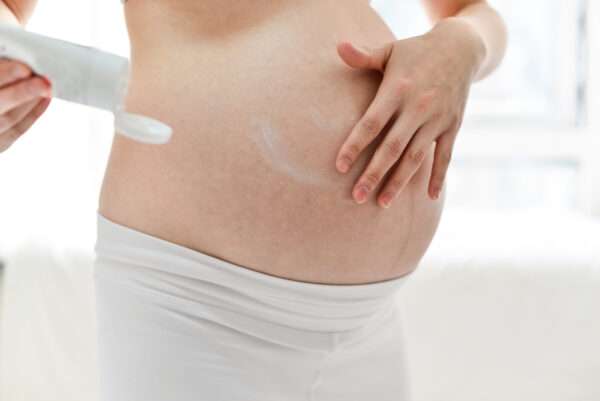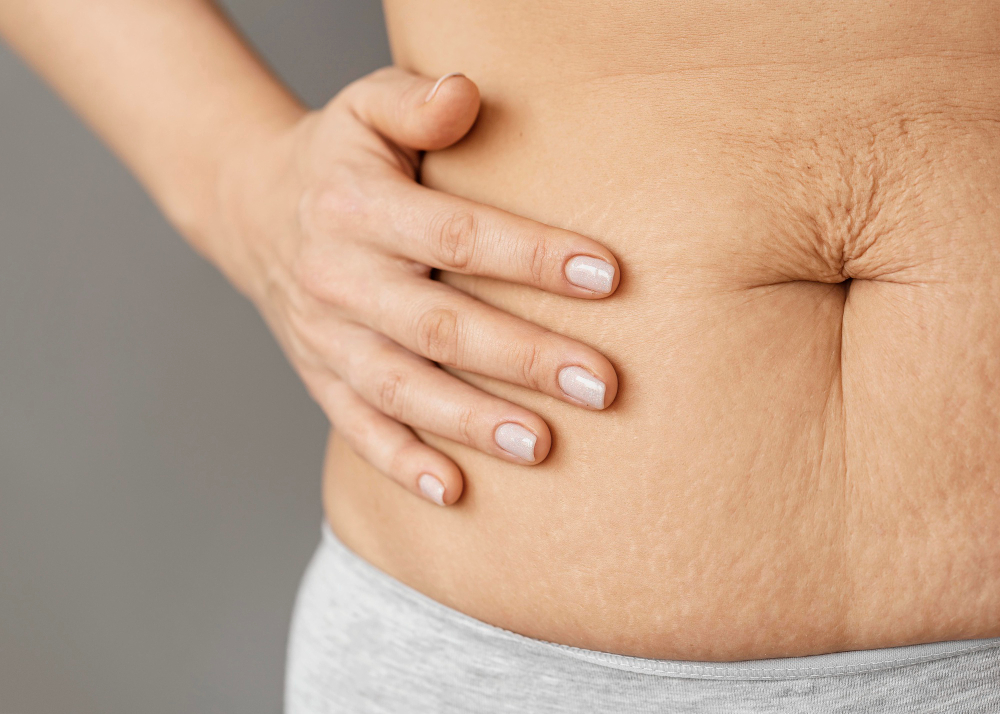
With the onset of summer, it’s time to whip out your favourite pair of shorts and your cutest crop tops. However, it’s only natural to become more aware of how your skin when you want to pull off these summer outfits. This is when you may notice those long, narrow streaks on your skin. Stretch marks can be a source of self-consciousness for many people, and if you’re curious about how to remove stretch marks, the good news is that there are ways to help reduce their appearance.
What Are Stretch Marks?
Stretch marks, medically known as striae, are a common skin condition characterised by thin, discoloured lines or streaks that develop when the skin undergoes rapid stretching or changes in size. They typically appear as red, purple, or pink lines initially and may fade to a silvery-white over time.
Stretch marks commonly occur during pregnancy, puberty, rapid weight gain or loss, and rapid muscle growth. They result from the tearing of the skin’s middle layer, the dermis, due to insufficient collagen and elastin production to accommodate the stretching. While they are not harmful, they can be cosmetically bothersome for some individuals.
What Causes Stretch Marks?
If you’re wondering “what are stretch marks” and how they appear in the first place, here are a few insights our experts provided. Stretch marks are a type of scarring that can appear on the skin when it stretches or shrinks beyond its limits. They are most commonly found on the stomach, thighs, hips, breasts, and upper arms. Here are some of the main causes of deep stretch marks.
- Rapid weight gain or loss can cause stretch marks. This can happen during pregnancy, puberty, or as a result of rapid muscle gain or weight loss.
- When the skin is stretched, the underlying collagen and elastin fibres can become damaged, leading to the appearance of stretch marks
- Hormonal changes can also play a role in the development of stretch marks. For example, pregnancy hormones can cause the skin to stretch more easily
- Genetics may also be a factor in the development of stretch marks. If your family members have stretch marks, you may be more likely to develop them as well
- Certain medications can make the skin more susceptible to stretch marks by reducing its elasticity
What are the Different Types of Stretch Marks?

There are several different types of stretch marks, which can be classified based on their cause, location, and appearance.
1. Striae Rubrae (Red Stretch Marks)
These are early-stage stretch marks that typically appear as pink, reddish, or purplish lines on the skin. They are often accompanied by itching and inflammation. Red stretch marks are more amenable to treatment and may fade over time.
2. Striae Albae (White Stretch Marks)
As stretch marks mature, they often fade to a lighter colour, which can be white or silver. Striae albae are older and less likely to respond to treatment compared to red stretch marks.
3. Striae Gravidarum
Also known as pregnancy stretch marks, these occur during pregnancy when the skin on the abdomen, breasts, and hips stretches rapidly to accommodate the growing baby. They can start as red or pink lines and may fade to white over time.
4. Striae Distensae
This is a general term for stretch marks that can occur due to various reasons, including rapid weight gain, growth spurts during adolescence, or the use of corticosteroid medications. They can appear on different parts of the body, including the thighs, buttocks, arms, and shoulders.
5. Striae Due to Bodybuilding
Bodybuilders and individuals engaged in intense strength training may develop stretch marks in areas where muscle growth occurs rapidly, such as the biceps and chest.
How to Get Rid of Stretch Marks Naturally
Natural remedies can help reduce the appearance of stretch marks, however, they cannot remove them permanently and completely. So if you’re looking for how to remove stretch marks fast, you may want to opt for clinical treatment. However, if you’re consistent with these remedies, you may be able to notice a change over time.
1. Vitamin E oil*
Known for its excellent antioxidant properties, vitamin E helps in the healing and regeneration of skin cells. It can prevent the formation of new stretch marks and fade the existing ones. Apply stretch mark creams with vitamin E oil to the affected areas and massage them gently for a few minutes. Leave it on overnight and rinse it off with warm water in the morning.
2. Hyaluronic acid*
Hyaluronic acid is a natural compound that helps the skin retain moisture, making it look more plump and healthy. It also helps in reducing the appearance of fine lines and wrinkles. Mix a few drops of hyaluronic acid with a carrier oil such as coconut or olive oil and apply it on the affected areas. Massage it gently and leave it on for a few hours before washing it off.
Check out the Volite skin treatment at Bodycraft clinic. It is a non-invasive anti-ageing treatment incorporating a skin-conditioning gel that contains hyaluronic acid and is designed to enhance skin quality that lasts for more than 6 months! This is injected into the layers of the skin to nourish it from the inside out, resulting in plump and healthy skin.
Deep Stretch Marks Treatment
If you’re looking for stretch mark treatments with instant and long-lasting results, it’s best to visit a skin care professional so that they can guide you with the right treatments. Our experts recommend the following mirconeedling treatment for stretch mark removal.
View this post on Instagram
MNRF Treatment
The microneedling radiofrequency (MNRF) treatment is a cutting-edge cosmetic procedure for skin renewal, addressing wide open pores, acne scars, and skin tightening. The technique uses radiofrequency waves to stimulate collagen formation, which shrinks pores by tightening your skin. The procedure causes a controlled skin injury that promotes the formation of healthy new skin and cures common skin problems like stretch marks, wrinkles, and acne scars.
The microneedle cartridge is placed on the surface of the skin and the microneedles penetrate inside the skin. After this bipolar RF energy is directly applied to the target areas and the process of collagen regeneration and new elastic production begins.
Takeaway
From maintaining topical treatments and seeking professional medical procedures, there are a variety of options available if you want to understand how to remove stretch marks. Stretch marks are a natural part of life, and everyone’s body experiences changes and growth over time. By taking care of your skin and embracing your unique beauty, you can feel confident and empowered in your own skin.
FAQs around Stretch marks
1. Can stretch marks go away fast?
Stretch marks fade away with time, however, it’s possible to reduce their appearance quickly with clinical treatments.
2. What stops you from getting stretch marks?
One of the most important things to control stretch marks is to control your weight and stay hydrated along with maintaining a well-rounded diet.
3. Can you get rid of stretch marks 100%?
No, it’s not possible to get rid of stretch marks permanently, however, there are ways to significantly reduce the appearance.
4. Can being overweight cause stretch marks?
Yes, stretch marks are often caused by rapid weight gain over a short period of time.
5. When should I consult a doctor for stretch marks?
Stretch marks are generally not a medical concern and are considered a cosmetic issue. However, if you are concerned about the appearance of your stretch marks or if they are associated with significant pain, itching, or changes in skin colour, it’s advisable to consult a dermatologist or healthcare provider for evaluation.
6. How to prevent stretch marks during pregnancy?
While it’s challenging to completely prevent stretch marks during pregnancy, you can minimise their severity by applying moisturisers and creams rich in cocoa butter, shea butter, or vitamin E to keep your skin hydrated.
7. Does laser stretch mark removal work?
Laser stretch mark removal and radiofrequency treatments like Micro-Needling Radiofrequency (MNRF) can be effective in reducing the appearance of deep stretch marks. These treatments work by stimulating collagen production and promoting skin regeneration.
8. Why do I have stretch marks on my hips?
Stretch marks can develop on various parts of the body, including the hips, due to rapid changes in skin tension and elasticity. Common causes of stretch marks include rapid growth during puberty, weight gain or loss, pregnancy, and muscle-building exercises.
9. Can skin peeling remove stretch marks?
Chemical peel are typically not used to remove stretch marks. While chemical peels can improve the texture and appearance of the skin by exfoliating the outer layer, they do not penetrate deep enough to address the underlying collagen and elastin fibres that are disrupted in stretch marks.
10. Do stretch marks go away when you lose weight?
Stretch marks do not usually go away completely on their own when you lose weight. Weight loss can reduce the tension on the skin, which may help make stretch marks less noticeable, but it won’t eliminate them entirely. The appearance of stretch marks can improve with time and treatments like laser therapy, but they are often permanent and may never fully disappear.
